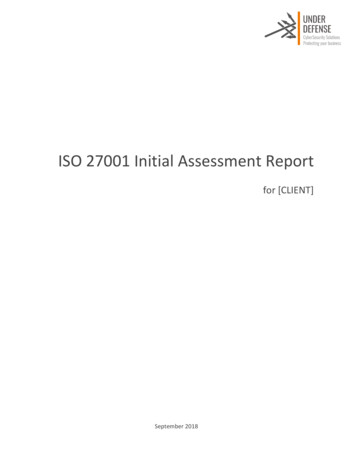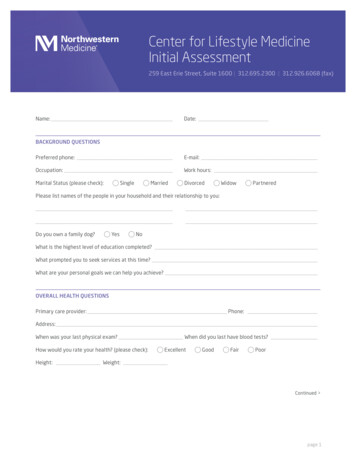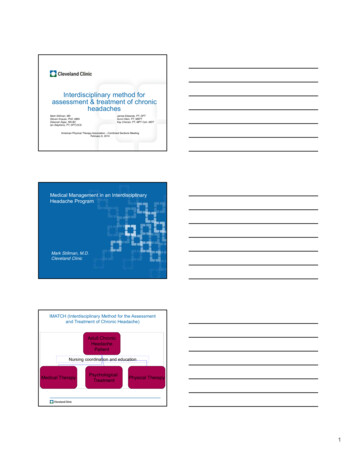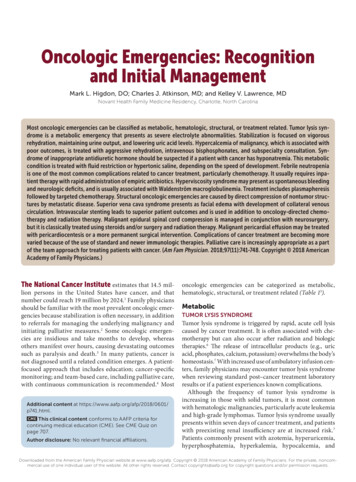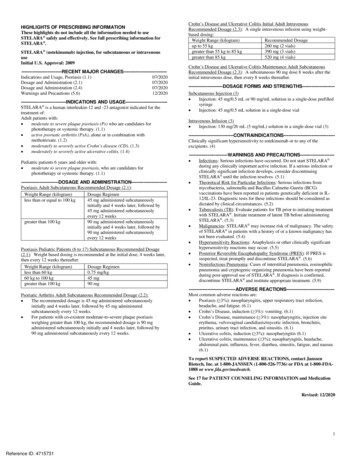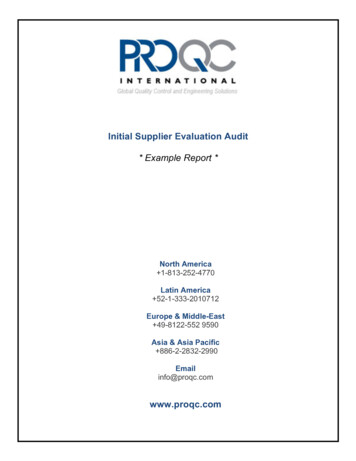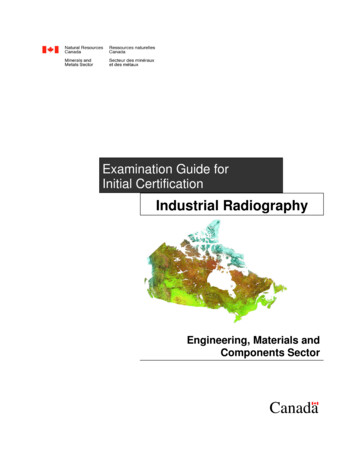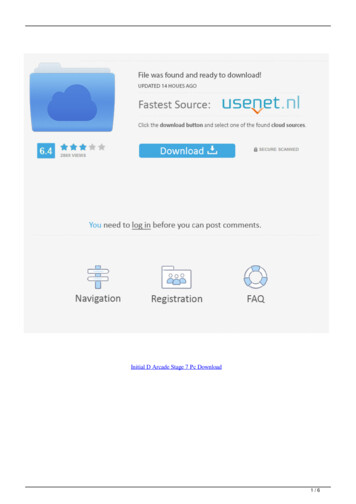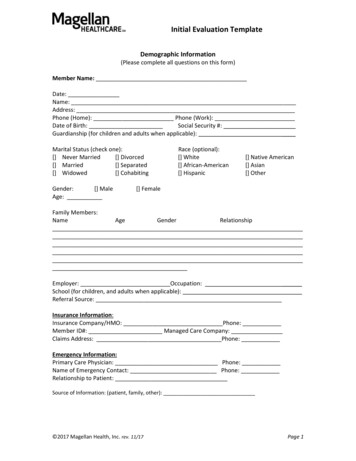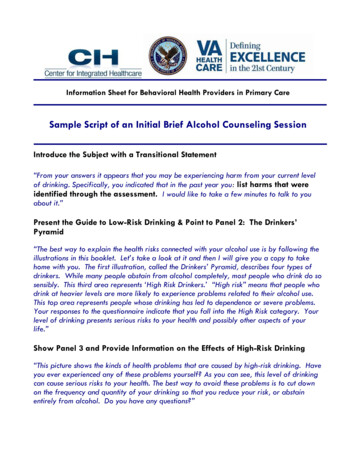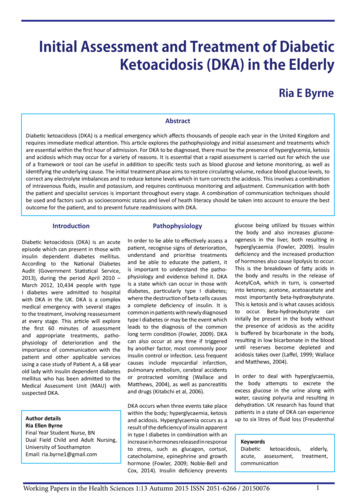
Transcription
Initial Assessment and Treatment of DiabeticKetoacidosis (DKA) in the ElderlyRia E ByrneAbstractDiabetic ketoacidosis (DKA) is a medical emergency which affects thousands of people each year in the United Kingdom andrequires immediate medical attention. This article explores the pathophysiology and initial assessment and treatments whichare essential within the first hour of admission. For DKA to be diagnosed, there must be the presence of hyperglycemia, ketosisand acidosis which may occur for a variety of reasons. It is essential that a rapid assessment is carried out for which the useof a framework or tool can be useful in addition to specific tests such as blood glucose and ketone monitoring, as well asidentifying the underlying cause. The initial treatment phase aims to restore circulating volume, reduce blood glucose levels, tocorrect any electrolyte imbalances and to reduce ketone levels which in turn corrects the acidosis. This involves a combinationof intravenous fluids, insulin and potassium, and requires continuous monitoring and adjustment. Communication with boththe patient and specialist services is important throughout every stage. A combination of communication techniques shouldbe used and factors such as socioeconomic status and level of heath literacy should be taken into account to ensure the bestoutcome for the patient, and to prevent future readmissions with DKA.IntroductionPathophysiologyDiabetic ketoacidosis (DKA) is an acuteepisode which can present in those withinsulin dependent diabetes mellitus.According to the National DiabetesAudit (Government Statistical Service,2013), during the period April 2010 –March 2012, 10,434 people with typeI diabetes were admitted to hospitalwith DKA in the UK. DKA is a complexmedical emergency with several stagesto the treatment, involving reassessmentat every stage. This article will explorethe first 60 minutes of assessmentand appropriate treatments, pathophysiology of deterioration and theimportance of communication with thepatient and other applicable servicesusing a case study of Patient A, a 68 yearold lady with insulin dependent diabetesmellitus who has been admitted to theMedical Assessment Unit (MAU) withsuspected DKA.In order to be able to effectively assess apatient, recognise signs of deterioration,understand and prioritise treatmentsand be able to educate the patient, itis important to understand the pathophysiology and evidence behind it. DKAis a state which can occur in those withdiabetes, particularly type I diabetes;where the destruction of beta cells causesa complete deficiency of insulin. It iscommon in patients with newly diagnosedtype I diabetes or may be the event whichleads to the diagnosis of the commonlong term condition (Fowler, 2009). DKAcan also occur at any time if triggeredby another factor, most commonly poorinsulin control or infection. Less frequentcauses include myocardial infarction,pulmonary embolism, cerebral accidentsor protracted vomiting (Wallace andMatthews, 2004), as well as pancreatitisand drugs (Kitabchi et al, 2006).Author detailsRia Ellen ByrneFinal Year Student Nurse, BNDual Field Child and Adult Nursing,University of SouthamptonEmail: ria.byrne1@gmail.comDKA occurs when three events take placewithin the body; hyperglycaemia, ketosisand acidosis. Hyperglycaemia occurs as aresult of the deficiency of insulin apparentin type I diabetes in combination with anincrease in hormones released in responseto stress, such as glucagon, cortsol,catecholamine, epinephrine and growthhormone (Fowler, 2009; Noble-Bell andCox, 2014). Insulin deficiency preventsglucose being utilized by tissues withinthe body and also increases gluconeogenesis in the liver, both resulting inhyperglycaemia (Fowler, 2009). Insulindeficiency and the increased productionof hormones also cause lipolysis to occur.This is the breakdown of fatty acids inthe body and results in the release ofAcetylCoA, which in turn, is convertedinto ketones; acetone, acetoacetate andmost importantly beta-hydroxybutyrate.This is ketosis and is what causes acidosisto occur. Beta-hydroxybutyrate caninitally be present in the body withoutthe presence of acidosis as the acidityis buffered by bicarbonate in the body,resulting in low bicarbonate in the blooduntil reserves become depleted andacidosis takes over (Laffel, 1999; Wallaceand Matthews, 2004).In order to deal with hyperglycaemia,the body attempts to excrete theexcess glucose in the urine along withwater, causing polyuria and resulting indehydration. UK research has found thatpatients in a state of DKA can experienceup to six litres of fluid loss cute, assessment, treatment,communicationWorking Papers in the Health Sciences 1:13 Autumn 2015 ISSN 2051-6266 / 201500761
et al, 2013). This in turn causes anelectrolyte imbalance in the body whichalso later needs to be addressed oncethe immediate threat to life has beenremoved (Eledrisi et al, 2006; Fowler,2009).AssessmentThe most important action on admissionis to carry out an initial rapid assessmentof the patient. The ABC framework iscommonly used for the initial assessmentof trauma patients; however it allowsclinicians to identify any immediate, lifethreatening concerns which is essentialwhen treating any patient. Rapid identification of any life threatening issues allowsappropriate interventions to be put intoplace in order to reduce or prevent riskof death or long term disability as a result(Skinner and Driscoll, 2013). Patient A isdrowsy but is able to respond verbally tostaff, therefore demonstrating that herairway is patent, she is breathing, and hasadequate circulation.Once any immediate threats to lifehave been identified and appropriatelyactioned, a more detailed assessmentcan be carried out. According to theNational Institute for Health andClinical Excellence clinical guideline 50(NICE, 2007), a minimum of heart rate,respiratory rate, systolic blood pressure,level of consciousness, oxygen saturationand temperature should be recordedboth at initial assessment and at regularintervals; at least every 12 hours. Risk ofdeterioration of a patient experiencingan acute episode is high, therefore NICEalso recommend the use of a track andtrigger system in all acute settings inorder to detect signs of deterioration asearly as possible. One such system thatis commonly used is a Modified EarlyWarning Score (MEWS) (appendix A Quinton and Higgins, 2012)A MEWS score can be calculated bycollection of vital signs, and shouldbe used in combination with clinicaljudgement (Alam et al, 2014). This scoregives an indication of risk of deterioration and triggers certain actions such asinforming the nurse in charge or seniorclinician. Calculation of a MEWS hasbeen found to trigger a more timelyresponse to deterioration and thereforean improved outcome for the patient(Ludikhuize et al, 2012). However,research has suggested that an accurateMEWS is not always calculated dueto certain vital signs, most commonlyrespiratory rate, not being recorded(Ludikhuize et al, 2011). On admissionto MAU, following the recording of vitalsigns, Patient A has a total MEWS of six.This means that the nurse in charge,junior doctor and consultant shouldbe contacted for immediate review, aswell as the critical outreach team. NICEclinical guideline 50 also recommendsthat the frequency of calculation of aMEWS should be increased if abnormalphysiology is recorded. As Patient A hasa MEWS of six, the system denotes thather MEWS should be recalculated every30 minutes until it has decreased to lessthan four. Research also suggests thatcalculation of a MEWS score, not only atthe initial assessment and then every 12hours, but at regular intervals throughoutthe day, is effective in recognising deterioration (Ludikhuize et al, 2014). Thissuggests that for best patient outcomeand early detection of any deterioration,the MEWS should be calculated at regularintervals for every patient not simply asoften as suggested by calculation of theprevious score.It has been found that MEWS is usefulin detecting DKA (Pepper et al, 2012)as defined by the criteria set out by theAmerican Diabetes Association (appendixB - American Diabetes Association citedin Pepper et al, 2012). Although thisstudy was not carried out in the UK, thefindings may helpful to guide furtherresearch within the UK as variationsof the MEWS are used throughout theworld. Also, the criterion which was usedto define DKA was created in the USAwhich is a country with similar economicstatus, lifestyles and patterns of ill healthto the UK, however the criteria differsslightly to those published by Joint BritishDiabetes Societies Inpatient Care Group(JBDS, 2010) and so this should be takeninto account.Abnormal vital signs are an indicationof the underlying pathophysiologydiscussed above; the presence of hyperglycaemia, ketoneamia/ketonuria andacidaemia (JBDS, 2010). In order to testfor hyperglycaemia and ketonaemia,blood glucose and ketone levels shouldinitially be checked by carrying out afinger prick test. A result of greater than11mmols/L of glucose and 3mmols/L ormore of ketones may be an indication ofDKA (Savage, 2011; Savage et al, 2011).If a ketone meter is unavailable, thepatient’s urine can instead be tested forketonuria by carrying out a dipstick test;a result of 2 or more may also indicateDKA. In order to test for acidaemia, avenous blood sample must be taken;venous samples have been found to be asreliable as arterial samples in this instanceand obtaining a venous sample is muchless invasive for the patient (Kelly, 2006;Savage et al, 2011). If the pH is less than7.3 or bicarbonate is less than 15mmol/l,this is further indication of DKA (Savage,2011; Savage et al, 2011). If the results forall the above tests are positive, a diagnosisof DKA can be made and appropriatetreatments put in place. Following thesetests Patient A is found to have a bloodsugar of 28mmol/l, ketones of 3.6mmol/l(and urine ketones of 3 ) with a bloodpH of 7.1. Bedside monitoring of bloodglucose and ketones should be repeatedhourly for the first six hours (JBDS, 2010).A venous blood gas also allows the identification of some other abnormal valuessuch as electrolyte levels, howeverfurther blood tests including full floodblood count, urea and electrolytes andcultures should be carried out to allowmore in depth analysis, as well as toidentify the presence of any infectionmarkers. Further investigations such asan Electrocardiogram (ECG) and a chestx-ray should also be carried out as partof the initial assessment (Kitabchi, 2006;JBDS, 2010; Noble-Bell and Cox, 2014).TreatmentThe initial assessment determines thecause of the acute episode and identifiesthe symptoms which need to be treatedfirst allowing clinicians to prioritiseappropriate therapeutic interventions.According to the JBDS (2010) the aim totreatment of DKA is to restore circulatingvolume, reduce blood glucose levels,correct any electrolyte imbalances and toreduce ketone levels therefore correctingacidosis. The following interventionsshould take place within the first hourfollowing admission, any part of theinterventions which should take placeafter the first hour are not discussed indetail.The first step in treating DKA is toadminister intravenous fluids (IVI) of0.9% sodium chloride solution in order torestore circulating volume. As mentionedabove, a patient presenting with DKAWorking Papers in the Health Sciences 1:13 Autumn 2015 ISSN 2051-6266 / 201500762
may have around six litres of fluid deficit,therefore it is essential that this debt isrestored immediately upon admission.If the patient’s systolic blood pressureis less then 90mmHg, an initial 500mlsshould be given over 10-15minutes,this can be repeated if blood pressureremains below 90mmHg. As Patient A hasa systolic blood pressure of 92mmHg, sheis commenced on the normal regime of1000mls over the first hour. After the firsthour, the fluids should then be changedto include potassium in order to addressthe inevitable electrolyte imbalance 0.9% sodium chloride with potassiumchloride should then be given at a rateof 500mls per hour for the next fourhours (appendix C – JBDS, 2010). Thisregime also notes that particular cautionshould be taken with the elderly. This isreiterated by earlier research which statesthat the regime should be administeredat a slower rate if the patient is elderly,as a higher infusion rate may increase riskof respiratory distress syndrome (Savageand Kilvert, 2006).have been addressed, the next aim is toprevent further production of ketones,clear the blood of ketones, and reverse theacidosis. The replacement of potassiumand reduction of hyperglycaemia shouldresult in the reduction of blood ketones byat least 0.5mmols/L/hr and an increase ofbicarbonate by 3mmol/L/hr. If this doesnot happen, the insulin infusion maybe increased by one unit per hour untiltargets are achieved. Due to the insulininfusion, blood glucose levels may fallmore rapidly than ketone levels. If bloodglucose levels fall below 14mmols/L,10% dextrose should be commencedalongside the IVI at a rate of 125mls/hr.Potassium levels should be continuouslymonitored and treatment adjusted toensure they remain within normal levelsof 4-5.5mmols/L. It is expected that DKAshould be fully resolved within 24 hoursof the commencement of the treatmentregime and patients should be back ontheir usual insulin regime (JBDS, 2010).Once the IVI has been started, the nextpriority is to address the hyperglycaemiaby administration of insulin, with the aimto reduce blood glucose by 3mmol/L/hr.It is recommended that 50 units of quickacting insulin such as Actrapid , shouldbe made up to 50mls with 0.9% salineand administered at a rate of one unit/kg/hour, alongside the IVI (JBDS, 2010).Evidence has shown that insulin givenaccording to weight rather than a setdose, allows for more accurate treatmentespecially in the instance of obesity andother insulin resistant states such aspregnancy
this is further indication of DKA (Savage, 2011; Savage et al, 2011). If the results for all the above tests are positive, a diagnosis of DKA can be made and appropriate treatments put in place. Following these tests Patient A is found to have a blood sugar of 28mmol/l, ketones of 3.6mmol/l (and urine ketones of 3 ) with a blood pH of 7.1. Bedside monitoring of bloodFile Size: 398KBPage Count: 7
